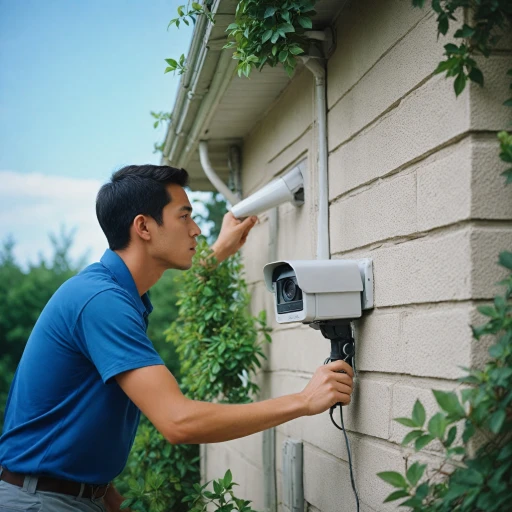
Understanding Non-Wi-Fi Surveillance Cameras
An Overview of Non-Wi-Fi Surveillance Solutions
Surveillance cameras without Wi-Fi are gaining widespread popularity among homeowners and businesses who prefer a straightforward security system without the reliance on internet connectivity. These cameras work independently of Wi-Fi signals, offering several alternative methods for data storage and transfer. Such setups can be ideal for locations where internet connection is inconsistent or non-existent.
Unlike traditional security solutions, a security camera without Wi-Fi connects through other technologies to provide video footage. Most notably, local storage options such as SD cards, NVR systems, or even cellular data plans offer viable backups for recorded videos. In the case of NVR security systems, wired cameras link to a network video recorder, which stores the footage onsite, ensuring that your recordings remain under your control without needing an internet connection.
It's important to note that non-Wi-Fi solutions still offer many high-tech features found in Wi-Fi-enabled cameras. This includes functionalities such as motion detection, night vision, and even remote access when paired with cellular technology. Solutions leveraging a SIM card or other cellular connectivity options can even send real-time alerts and footage, keeping you informed regardless of your location.
For those who appreciate autonomy in their security systems, exploring the benefits of wireless security cameras without Wi-Fi might be of interest. As covered in Exploring the Benefits of a Dash Cam with a Rechargeable Battery, the idea of relying solely on what you can control without external dependencies is becoming increasingly attractive.
Advantages of Using Surveillance Cameras Without Wi-Fi
Opting for a Secure Connection
Many homeowners are becoming increasingly interested in security cameras that operate without the need for Wi-Fi. One of the primary advantages is enhanced security through the use of local storage systems. By opting for surveillance cameras that rely on methods other than Wi-Fi, such as local or cellular data storage, users can benefit from a more secure setup. Without the dependency on a Wi-Fi connection, these cameras are less vulnerable to internet interruptions or breaches. This ensures continuous monitoring even when there’s an internet outage, providing peace of mind to those who seek a more reliable security system.Flexible Placement Options
Wireless security cameras without the need for a Wi-Fi connection also allow for greater flexibility in terms of placement. Since they're not tethered to an existing network, users can position these cameras in locations that might otherwise be out of reach, such as rural areas or locations lacking stable internet access. Models that utilize cellular connections or local storage effectively sidestep this issue, broadening options for strategic installations. With options such as NVR systems, users can gather video footage directly through hardwired connections, circumventing Wi-Fi altogether. Additionally, some cameras come equipped with a sim card slot, allowing connection via a cellular network when setting up intrudes beyond the limitations of a home internet system.Efficient Data Management
Utilizing a surveillance system without Wi-Fi paves the way for effective data management through local storage options like SD cards. This setup can help safeguard your data from potential cyber threats, as footage is physically stored and not reliant on third-party cloud storage systems that may require an internet connection. Without Wi-Fi, your security cameras work to store their surveillance footage on local devices, such as SD cards or network video recorders (NVRs), ensuring you have uninterrupted access to your data. It's an effective approach for those prioritizing data security over convenience, with added advantages of being immune to cyber intrusions that specifically target internet-connected devices. For those interested in ways to improve safety around the home without entirely depending on internet solutions, you may find value in discovering more about how battery-powered motion lights enhance security systems without Wi-Fi reliance.Potential Drawbacks and Considerations
Understanding the Drawbacks of Non-Wi-Fi Surveillance Options
When considering surveillance cameras that work without Wi-Fi, there are several potential drawbacks and considerations to keep in mind. It's essential to balance the benefits with these factors to make sure this system aligns with your security needs.Limited Remote Access
One primary consideration is the limitation on remote access to the live video feed. Unlike cameras connected to a wireless network, non-Wi-Fi options can't offer real-time viewing through internet connection. This means monitoring your premises remotely may not be possible. If you need round-the-clock surveillance that's always accessible from any location, security camera systems that do not rely on Wi-Fi might not meet your requirements.Storage and Video Management
Another aspect to consider is the video storage system. Non-Wi-Fi cameras typically use local storage, such as an SD card or a local NVR system, for recording footage. While this might alleviate concerns about data privacy often associated with internet-based storage, it can also pose challenges, including the capacity limits of local storage devices and the physical management of video footage.Maintenance and Upkeep
Without the ability to update firmware over a wireless network, non-Wi-Fi cameras require more hands-on maintenance. Regular checks are necessary to ensure the camera is functioning correctly, especially since any updates or necessary software tweaks need manual implementation. Additionally, without wireless connection support, the setup might require additional effort, which might increase complexity.Limited Features
While these cameras offer some basic functionalities like motion detection and night vision, they might lack advanced features provided by Wi-Fi enabled systems, such as cloud-based video analytics or integration with smart home devices. This is an important factor if you're considering enhancing your home security with innovative solutions like a POE camera system, which can offer more advanced features and connectivity options. Considering these drawbacks will help determine if a non-Wi-Fi camera system is suitable for your security needs. While the absence of a wireless network might pose some challenges, understanding these can help better evaluate if these cameras work for your home or business environment.Types of Non-Wi-Fi Surveillance Cameras
Different Types of Offline Surveillance Cameras
Exploring the variety of surveillance cameras that do not rely on Wi-Fi or internet connections can provide a clearer picture of the available options for secure home surveillance.- Wired Analog Cameras: These cameras connect directly to a digital video recorder (DVR) through coaxial cables. Oftentimes, they are preferred for stable connections and consistent footage without the risk of wireless interference. They provide local storage options, offering a level of security and dependability unmatched by cloud-based systems.
- NVR Security Systems: Network Video Recorders (NVR) can also function without Wi-Fi, often using an Ethernet cable for a steady and reliable video feed. The cameras in these systems are typically IP-based, and they record high-definition footage, which is stored locally for quick access.
- Cellular Security Cameras: Using a SIM card, these cameras rely on cellular data for transmission and do not require a traditional internet or Wi-Fi connection. Ideal for remote locations where Wi-Fi isn’t available, they offer an effective alternative for surveillance, with video footage accessed via the cellular network.
- MicroSD Card Security Cameras: Some standalone security cameras have local storage capabilities via microSD cards. These cameras record footage onto the card itself, making them independent from any internet connection. However, managing storage capacity on these small cards can be a challenge if not regularly monitored and maintained.
- Battery-Powered Cameras: Operating without any external power source, these wireless cameras are suitable for areas without electricity. While some may offer Wi-Fi connectivity, many prioritize storage on local media, such as SD cards, hence not strictly needing internet connectivity to function effectively.
Installation and Maintenance Tips
Setting Up and Maintaining Your Non-Wi-Fi Surveillance System
For a successful installation of surveillance cameras without Wi-Fi, understanding how they work is crucial. These cameras operate independently and offer enhanced security by eliminating concerns over internet-based vulnerabilities. Here are some essential tips to ensure a seamless setup and ongoing maintenance:- Select the Right Location: Carefully choose the location for your camera system. Position security cameras where they can capture the desired footage without obstructions. Consider areas with adequate lighting or opt for models with night vision capabilities for 24/7 surveillance.
- Ensure Stable Power Supply: Non-Wi-Fi cameras can be wired or battery-powered. A stable power connection is vital for continuous operation. Regularly check and replace batteries if required or ensure a stable power source for wired options.
- Storage Considerations: Non-Wi-Fi security cameras rely on local storage options, like SD cards or NVR systems, to save video footage. Ensure you have adequate storage capacity for your footage, and remember to periodically clear or back up these storage devices to maintain available space.
- Test the Setup: After installation, thoroughly test the cameras to confirm they cover the intended areas and that video footage is being properly recorded and stored. Adjust camera angles if needed to capture optimal views.
- Regular Maintenance: Schedule regular inspections and cleaning for your cameras. Remove any debris or dirt that could obscure the lens, and check for any signs of wear that might affect performance.
- Update Access Options: Consider how you access the recorded footage. Some systems might allow direct local access, while others might offer cellular data options using a sim card for remote connectivity without internet.
Choosing the Right Camera for Your Needs
Selecting the Best Camera to Suit Your Needs
When considering security cameras without an internet connection, it’s essential to focus on their specific features to find the right match for your surveillance needs. Here’s a guide to help you make an informed decision:
- Determine Your Surveillance Goals: Begin by outlining what you aim to achieve with your security camera system. Whether it's deterring potential intruders or monitoring a specific area, clarity on your objectives will guide your choices.
- Assess Camera Features: Prioritize features such as night vision, motion detection, and local storage options, which allow cameras to record footage without the need for internet or cloud connections. For instance, a camera system equipped with local video storage—such as a built-in microSD card—could be beneficial in circumstances where wifi security is not applicable.
- Consider Power Source: Evaluate whether a camera system powered by batteries or a wired connection suits your setting better. Wireless cameras offer flexibility but keep in mind to check battery life and ease of recharging or replacement.
- Look Into Compatibility: If you have existing security infrastructure, such as nvr security setups, verify the compatibility of new cameras to ensure seamless integration into your current surveillance ecosystem.
- Evaluate External Conditions: If installing outdoors, select cameras with weather-resistant features, ensuring they can withstand external elements over time.
- Check for Remote Access Options: While cameras that don't rely on wifi avoid internet vulnerabilities, some may offer remote access capabilities via a cellular data connection, using a sim card to send footage directly to your devices.
Choosing security cameras that work without wifi requires a focus on these key elements, ensuring your setup provides optimal protection tailored to your unique needs. Each feature contributes to building a robust home security system that delivers peace of mind without reliance on a constant internet connection.












